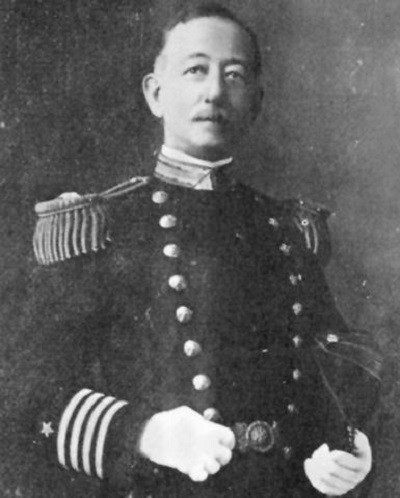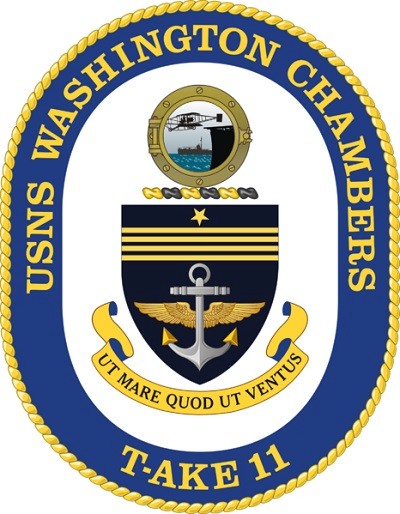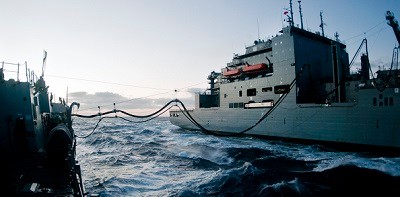Washington Chambers (T-AKE-11)
2011–
Washington Irving Chambers, born in Kingsport, New York, on 4 April 1856, graduated from the Naval Academy, Annapolis, Md., in 1876. He served on board screw steamer Pensacola, and then in sloop of war Portsmouth (1877–1878) and Marion (1879–1882). Chambers served briefly ashore with the Bureau of Navigation, but momentous events overtook the young ensign.
During 1883–1884, the Lady Franklin Bay Expedition, a polar exploration party of 25 men under the command of Lt. Adolphus W. Greely, U.S.A., wintered at Cape Sabine, Canada, but suffered from inadequate provisions and stores. Comdr. Winfield S. Schley broke his flag in auxiliary steamer Thetis in command of an expedition to rescue the stranded men before they succumbed to the fierce Arctic weather and starvation. The expedition also included screw steamer Bear and British steamer Alert, a former five gun sloop of war converted for polar exploration. Chambers sailed in Alert, Cmdr. George W. Coffin in command.
After more than a month of preparations, Schley led the expedition from New York on 1 May 1884. Ice floes and heavy weather hampered their search, and Thetis only reached her jumping-off point at Upernavik, Greenland, toward the end of the month. Bear and Thetis sailed from that port on 29 May and steered northward, reaching Littleton Island on 21 June. Search parties landed and discovered evidence that Greely and his men had stopped there but moved on. The following day, Thetis sailed to Payer’s Harbor and landed men to scour Brevoort Island. More evidence that Greely had passed that way also indicated the dire straits that plagued the expedition. Later that day (23 June 1884), the two ships rounded Cape Sabine and, while fighting a howling gale, discovered Greely and six companions alive, but weak from exposure and malnutrition. The other 20 men of the expedition had perished. The next day, the two ships headed south with the survivors. After stops at Upernavik, Godhavn, Greenland, and St. John’s, Newfoundland, the relief expedition arrived in Portsmouth, N.H., on 1 August. During the five-day stay, rescuers and rescued alike received a tumultuous welcome by the assembled North Atlantic Squadron and the people of Portsmouth. The ships then sailed south and returned Greely and his men to New York (5–8 August).
Chambers then served successively in the Office of Naval Intelligence (1884–1888), the New York Navy Yard (1888–1889), Petrel (Gunboat No. 2) (1889–1891), and protected cruiser Atlanta (1891–1892). He married Isabella Reynolds in 1892. He then served ashore at the Naval War College, Newport, R.I. (1892–1893), as the Inspector of Ordnance at the Philadelphia Navy Yard, Pa. (1894–1895), and returned to sea on board Minneapolis (Cruiser No. 13) (1895–1897). Chambers reported to Naval Torpedo Station, Newport, R.I. (1898–1899), and then held a series of sea assignments on board battleship Texas (1899–1900), Annapolis (Gunboat No. 10) (1900–1902), and converted yacht, used as a patrol vessel, Frolic (1902), before returning to Newport and the torpedo station there (1902–1904). He followed those assignments with service on board Nashville (Gunboat No. 7) (1905–1906), Florida (Monitor No. 9) and Newark (Cruiser No. 1) (1906–1907). He then served as the Assistant Chief of the Bureau of Ordnance (BuOrd) (1907–1909), followed by brief duty in Louisiana (Battleship No. 19).
In 1910, the Navy made a place for aviation in its organizational structure when Capt. Chambers was designated as the officer to whom all aviation matters were to be referred. Although holding no special title, he pulled together existing threads of aviation interest within the Navy and gave official recognition to the proposals of inventors and builders. Before the service had either planes or pilots, he arranged a series of tests in which civilian aircraft designers and entrepreneurs Glenn H. Curtiss and Eugene B. Ely dramatized the airplane’s capability for shipboard operations and showed the world and a skeptical fleet that aviation could go to sea.
The need for more science and less “rule of thumb” became apparent to Chambers. He collected the writings and scientific papers of leaders in the new field, pushed for a national aerodynamics laboratory, and encouraged naval constructors to work on aerodynamic and hydrodynamic problems. The Navy built a wind tunnel, and the nation established the National Advisory Committee for Aeronautics. A board under Chambers’ leadership conducted the first real study of what was needed in aviation and included in its recommendations the establishment of a ground and flight training center at Pensacola, Florida, the expansion of research, and the assignment of an airplane to every major combatant ship of the Navy.
Secretary of the Navy George von L. Meyer informed the Aeronautical Reserve (an organization of private citizens formed to advance aeronautical science as a means of supplementing the national defense) that Capt. Chambers, Assistant to the Aid for Material, had been designated as the officer to whom all correspondence on aviation was to be referred, on 26 September 1910, the first recorded reference to a provision for aviation in Navy Department organization. On 13 October, Meyer approved the recommendation of the Chief Constructor that an officer from the Bureau of Construction and Repair, and another from the Bureau of Steam Engineering, were to be appointed to investigate the subject of aviation and gain technical knowledge of airplanes, and directed that these officers keep Chambers, previously designated to serve in a similar capacity in the Secretary’s office, fully informed of the work contemplated and the results of all experiments.
The International Aviation Tournament opened at Belmont Park, N.Y., on 22 October 1910. Capt. Chambers, Assistant Naval Constructor William McEntee, and Lt. Nathaniel H. Wright, the three men recently named to investigate aviation, attended as official Navy observers. The Wright Co., made a formal offer to train one pilot for the Navy contingent upon the purchase of one airplane for the sum of $5,000, on 9 March 1911. Naval officials expressed their displeasure at the contingency, and Chambers could not immediately arrange for the order of the aircraft, so the company repeated the offer without the contingency four days later.
Chambers, the officer in charge of aviation, reported for duty with the General Board, on 1 April 1911. Adm. George Dewey suggested the move because of a lack of space for aviation in the office of the Aid for Operations and to enable Chambers to have a stronger voice to impact policy. On 14 April, Chambers had just begun to serve within the General Board to facilitate his influence on policy, however, Congress had allocated a $25,000 appropriation for aviation within the budge of the Bureau of Navigation (BuNav). Consequently, the embryo office of Naval Aviation transferred from the General Board and was established in BuNav.
Chambers prepared requisitions for two Curtiss biplanes, on 8 May 1911. One, the Triad, was to be equipped for arising from or alighting on land or water; with a metal tipped propeller designed for a speed of at least 45 miles per hour; with provisions for carrying a passenger alongside the pilot; and with controls that either the pilot or passenger could operate. The machine described became the Navy’s first airplane, Curtiss hydroaeroplane A-1 (AH-1). These requisitions lacked the signature of the Chief of BuNav, necessary to direct the General Storekeeper to enter into a contract with the Curtiss Co., but they indicated Chambers’ decision as to which airplanes the Navy should purchase. The Navy thus considers 8 May the date upon which the service ordered its first airplane, and the official birthday of naval aviation.
Lt. Theodore G. Ellyson flew A-1 (AH-1) from Lake Keuka to Hammondsport, N.Y., on 3 July 1911. Ellyson took Chambers on this, the first night flight by a member of the Naval Service, to Pen Yan, but light winds kept the plane from climbing aloft and it taxied 22 miles. At 2015, Ellyson lifted off to return alone. The machine stopped for oil at the lake after dusk, but the distance to the lake’s surface appeared misleading in the darkness and the aircraft struck the water. The plane rose again and landed successfully on the water on the second attempt without the aid of lights at 2045. These marked the 12th and 13th flights of A-1.
Three days later, Chambers received orders for temporary duty at the Naval Academy in connection with the establishment of an aviation experimental station, the site for which had been previously selected on Greenbury Point near Annapolis. Although the aviators did not occupy the site until September, this became the first base for naval aviation.
A memorable experiment in the Navy’s search for a shipboard launching device concluded at Hammondsport, N.Y., on 7 September 1911, when Ellyson made a successful takeoff from an inclined wire rigged from the beach down to the water. “The engine was started and run at full speed and then I gave the signal to release the machine,” he reported. “I held the machine on the wire as long as possible as I wanted to be sure that I had enough headway to rise and not run the risk of the machine partly rising and then falling,” he continued, “Everything happened so quickly and went off so smoothly that I hardly knew what happened except that I did have to use the ailerons, and that the machine was sensitive to their action.”
Capt. Charles F. Pond, who commanded Pennsylvania (Armored Cruiser No. 4), suggested the technique, and Chambers and Curtiss developed the method to the point of the test.
On 16 October 1911, Chambers described plans for a scientific test of hydroaeroplane floats in a letter, to take place at the Washington Navy Yard Model Basin, D.C. He stated that a model of the pontoons with Forlanini planes (hydrovanes) neared readiness for testing. Chambers continued to search for improved power plants, and in a letter to Curtiss the following day, he discussed heavy oil (or diesel) engines and turbine engines similar in principle to those that, some thirty years later, would make jet propulsion practical. Chambers wrote, “In my opinion, this turbine is the surest step of all, and the aeroplane manufacturer who gets in with it first is going to do wonders.”
The search for a shipboard launching device continued as Chambers reported, on 26 December 1911, that the BuOrd expressed interest in experimenting with a catapult for launching aeroplanes, somewhat after the manner of launching torpedoes. Chambers noted that they decided to make a trial “with a device that gathers speed more gradually, something like the Curtiss air cylinder such as we use in ammunition hoists.” These observations indicate the genesis of the Navy’s compressed air catapult.
Assistant Naval Constructor Lt. Holden C. Richardson, CC, defined interest in steel and aluminum as aircraft structural materials in a letter to Chambers on 9 March 1912: “From all I can gather, there is little doubt that much greater confidence would be felt if pontoons were constructed with a metal skin…It would be unwise to make any requisition for such a construction until a practically standard design has been developed.”
Ellyson made the Navy’s first attempt to launch an airplane by catapult, in A-1, at a dock at the Naval Academy, Annapolis, Md., on 31 July 1912. A-1 (not secured to the catapult) reared at about mid-stroke and a cross wind caught the plane and threw it into the water, although the pilot escaped without serious injuries. That catapult, powered by compressed air, was constructed at the Naval Gun Factory at the Washington Navy Yard, from a plan that Chambers proposed.
President William H. Taft, acting on a recommendation made by Secretary Meyer, created a “Commission on Aerodynamical Laboratory” to determine the need for and a method of establishing such a laboratory, on 19 December. Chambers and Naval Constructor David W. Taylor represented the Navy on the commission.
On 13 March 1913, Chambers received the medal of the Aeronautical Society for the year 1912, recognizing “…his unusual achievements in being the first to demonstrate the usefulness of the aeroplane in navies, in developing a practical catapult for the launching of aeroplanes from ships, in assisting in the practical solution of the hydroaeroplane by the production in association with others of the flying boat, in having been instrumental in the introduction into our halls of Congress of bills for a National Aerodynamic Laboratory, and a Competitive Test, and through his perseverance and able efforts in advancing the progress of Aeronautics in many other channels.”

Secretary Meyer approved the performance standards for qualification as a Navy Air Pilot, and the issuance of a certificate to all officers meeting the requirements, on 10 April 1913. Chambers described these requirements as being different from those of the “land pilot,” and more exacting than those of the international accrediting agency, the Fédération Aéronautique Internationale. The Navy meanwhile ordered Chambers to retire, but he consented to remain on active duty at retired pay, in order to continue his work in developing naval aviation.
On 9 May 1913, President Woodrow Wilson approved the designation of representatives of governmental departments to serve on an advisory committee for the Langley Aerodynamical Laboratory, which the Smithsonian Institution reopened on 1 May. Chambers and Lt. Richardson represented the Navy. Chambers helped establish the first naval air station at Pensacola, Fla.
On 7 October 1914, Secretary of the Navy Josephus Daniels appointed a board of officers, with Chambers as the senior member, to draw up “a comprehensive plan for the organization of a Naval Aeronautic Service.” Additional members of the board included Commanders Carlo B. Brittain and Samuel S. Robison, Lieutenants Manley H. Simons and John H. Towers, Richardson, and 1st Lt. Alfred A. Cunningham, USMC.
The board’s report, submitted after 12 days of deliberation, emphasized the need for expansion and for the integration of aviation with the fleet, and was in all respects the first comprehensive program for an orderly development of naval aviation. The members’ recommendations included the establishment of an Aeronautic Center at Pensacola, Fla., for flight and ground training and for the study of advanced aeronautic engineering; the establishment of a central aviation office under the Secretary to coordinate the aviation work of the Bureaus; the assignment of a ship for training in operations at sea and to make practical tests of equipment necessary for such operations; the assignment of one plane to every major warship; and the expenditure of $1,297,700 to implement the program.
Capt. Mark L. Bristol reported to the Navy Department for special duty as officer in charge of aviation, and relieved Chambers of that duty on 17 December 1914. Chambers retired in 1919. He died while en route from the Pacific coast to Washington, D.C., on 23 September 1934. Chambers Field at Norfolk, Va., was dedicated in his honor on 1 June 1938.
(T-AKE-11: displacement 42,528; length 689; beam 106'; draft 30'; speed 20 knots; complement 197; armament up to 6 .50 caliber or 7.62 millimeter machine guns and two Sikorsky MH-60S Knighthawks or two Eurocopter (Aérospatiale) AS332 Super Pumas; cl. Lewis and Clark)
Washington Chambers (T-AKE-11) was laid down on 24 August 2009 at San Diego, Calif., by General Dynamics National Steel and Shipbuilding Co.; launched on 11 September 2010; sponsored by Mrs. Loretta Penn, wife of B. J. Penn, Assistant Secretary of the Navy (Energy, Installations and Environment), and former Acting Secretary of the Navy; and was placed in service with the Military Sealift Command on 23 February 2011.

Shield
Dark blue and gold are the colors traditionally used by the Navy. Gold is also for honor and a job well done. Washington Chambers is an auxiliary dry cargo ship with the primary mission to provide a steady stream of ammunition, spare parts, and provisions (dry, refrigerated, and frozen) to meet the Navy’s sealift needs. The wings, reflecting the wings on the Naval Aviator Badge, and the anchor, symbol of sea prowess, commemorate Capt. Chambers. The star and four bars refer to his rank and his high achievement of being the first to have oversight of the Navy’s aviation program.
Crest
The porthole is used to look through to the past to 1910 and the first flight launched from the bow of a cruiser that confirmed the potential of carrier-based aviation. Chambers arranged the world’s first airplane flight from a warship.

Detailed history under construction.
Mark L. Evans
22 January 2014


